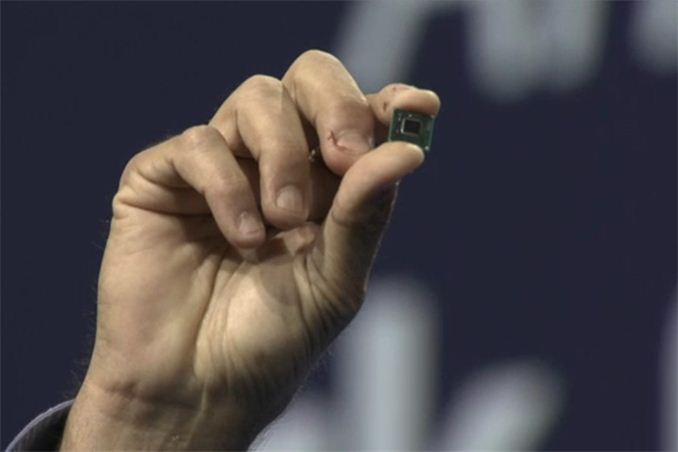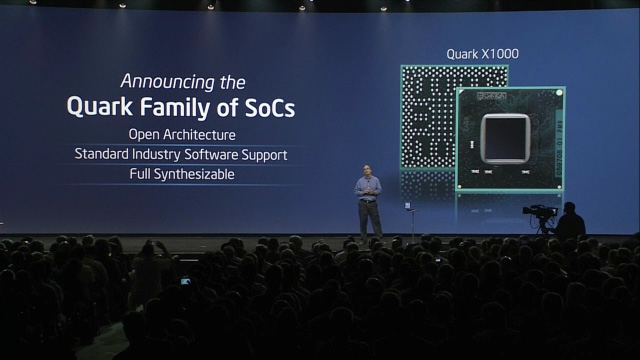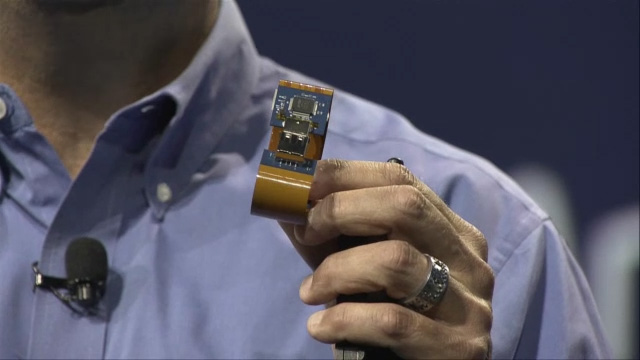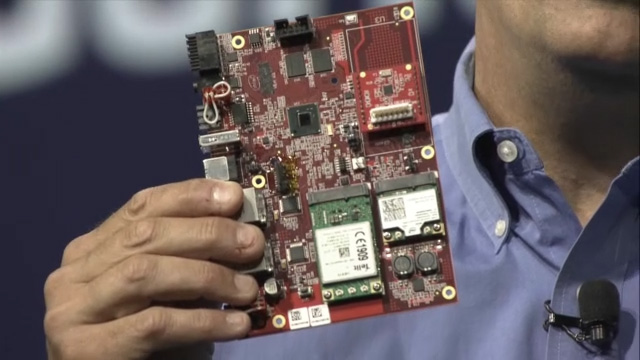Intel Announces “Quark” SoC Family: Tiny SoCs For Tiny Devices
by Ryan Smith on September 10, 2013 2:05 PM EST
Kicking off today is the 2013 Intel Developer Forum, Intel’s annual gathering of developers, press, and techies. Among the many sessions scheduled over the rest of the week we’re expecting several product announcements, and as is customary the first few of these announcements have been dropped in this morning’s opening keynote, being delivered by Intel’s new CEO, Brian Krzanich.
The first – and certainly hottest item – is the announcement of a new line of SoCs from Intel. Dubbed the Quark family, these SoCs will be slotted in below Intel’s existing and future Atom products, being designed with a strong emphasis on size and power consumption. Intel isn’t giving the press any hard numbers at this time, but they are throwing around the idea of one-fifth the size and one-tenth the size of their existing low-end Atom (Silvermont) CPU cores. Based on these statements a quick extrapolation in turn suggests that the die size of Quark is going to be under 10mm2 and targeting power consumption under 100mW, reinforcing just how small and low power Intel is going with these chips.
Update: Intel has sent over a quick clarification on size; the size comparisons are meant to be core-to-core rather than SoC-to-SoC. Specifically compared to the 22nm Silvermont core.

Being smaller, lower power, and less powerful than Atom, Intel will be chasing after the “internet of things” market with Quark products. With Atom covering tablets, smartphones, and similar devices, Intel is tasking Quark with covering the markets that traditionally use embedded microprocessors and other types of low power, low performance controllers. This would cover everything from wearable computers to smart watches on the consumer side, and any number of uses in industrial products as we already see today. Intel for their part isn’t going to be going into producing any such end user devices, but they are showing off some braclet-like devices as proof of concept reference designs at the show.
Looking at the specs and the use cases, although Intel doesn’t specifically name ARM as a competitor here, it’s clear that Intel is going after ARM’s other market segments to at least some extent with Quark. ARM’s Cortex M and Cortex R processor IP already competes in the spaces that Intel is naming for Quark, so there is some obvious overlap there. Furthermore ARM juggernaut Qualcomm has shown a clear interest in the “internet of things” concept and its potential to be the next explosive market, and have in turn been working on their own Cortex M based designs and sample products using them, such as the recently announced Toq smartwatch.

But perhaps the most interesting aspect of Quark is what hasn’t been said: architecture. Intel has not specifically named the architecture that Quark will be based on, which calls into question whether it will be based on x86 – like virtually all of Intel’s other microprocessors – or if they’re utilizing another architecture to meet the extreme size and power requirements of Quark. At the same time Intel is calling Quark an “open architecture” product, which is not a term they typically attach to x86. Hopefully we’ll be able to get Intel to talk more about the architecture once we hit the showfloor.
Update: Intel has confirmed to us that Quark's architecture is "Pentium ISA compatible", making it x86 for the purposes of the front-end.
Wrapping things up, alongside the announcement of Quark Intel has also briefly laid out their launch plans for the new SoC. As to be expected, Quark isn’t shipping yet. The first Quark product will be 32nm, with Intel sampling reference boards based on that SoC in the 4th quarter, followed by a full release occurring at a yet-to-be-announced point after that. For the initial wave of Quark products Intel will be playing it conservatively, targeting existing industrial microcontroller users such as energy, transportation, and other general industrial segments. These are the markets where Quark is closest to a drop-in replacement, while Intel’s more ambitious vision for consumer markets will take further time to develop as their partners continue to work out product designs and where such an SoC makes sense.

Source: Intel










26 Comments
View All Comments
Mondozai - Tuesday, September 10, 2013 - link
Awesome that you guys are at the IDF and that the Apple event isn't soaking up all the oxygen. I was a bit disappointed over the paltry coverage of the Qualcomm event recently, their Vuforia stuff was pretty awesome, judging from their keynote, which I saw later after the event was finished.I hope this article isn't an aberration but part of an ongoing series to cover this year's IDF conference in detail.
Krysto - Tuesday, September 10, 2013 - link
Everything Intel wants to do in the lower-end markets, ARM can do better, with less power, and cheaper.ARM has been having chips like this for years. Intel is trying to enter again in a market completely dominated by ARM, and they'll have just as much success as in the smartphone market, which is to say: not much.
Nagorak - Tuesday, September 10, 2013 - link
We'll see about that. I think Intel has been like a sleeping giant. Now that they've awoken I think they can take the fight to ARM. They have a huge process advantage and a great deal of experience with X86.StrangerGuy - Tuesday, September 10, 2013 - link
"targeting existing industrial microcontroller users such as energy, transportation, and other general industrial segments"So Intel saving like 1W on 1KW+ equipment = ARM is deader than dead wooooooo. A solution looking for an non existent problem.
Klimax - Wednesday, September 11, 2013 - link
ARM can't make anything. They're producing only designs... I think you thought Qualcomm or Samsung, but I wouldn't rather bet on them having some innate ability Intel doesn't have.Daniel Egger - Tuesday, September 10, 2013 - link
lol, what a name. Quark is also a German word for curd and quite often used as synonym for nonsense that someone is claiming.ClockworkPirate - Tuesday, September 10, 2013 - link
Also, it's a subatomic particle (smaller than an atom, get it?).kenyee - Tuesday, September 10, 2013 - link
And how does this compare w/ ARM chips in idle/run modes???irrationalJohn - Tuesday, September 10, 2013 - link
I keep hoping that someone will give an explanation of just what the heck is meant by Intel "calling Quark an “open architecture” product". I'm very curious to learn how “open architecture” can be morphed into "Pentium ISA compatible".Impulses - Wednesday, September 11, 2013 - link
Anything can be morphed however in pseudo marketing speak.